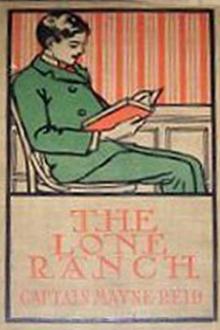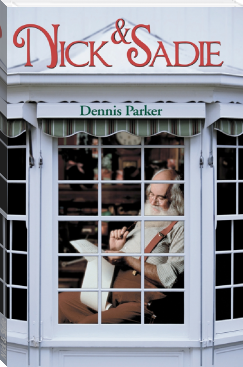The Lone Ranche, Mayne Reid [romantic love story reading txt] 📗

- Author: Mayne Reid
Book online «The Lone Ranche, Mayne Reid [romantic love story reading txt] 📗». Author Mayne Reid
Neither does Uraga nor his lieutenant escape the scalping-knife. Before the savages part from the spot, the crowns of both show crimson, while the scalps stripped off appear as trophies on the points of two Apache spears.
Not long do the Indians dally on the ghastly ground. Soon forsaking it, they continue on down the creek. Not in pursuit of the party which has so opportunely furnished them with spear-pennons and fringes for their leggings. The testimony of so many dead men, with the tracks of so many horses—horses with large hoofs, evidently not ridden by Mexicans, whom they contemn, but Texans they terribly fear; these evidences make the Apaches cautious, and, keeping on towards the Pecos, they go not as pursuers, but men trying to shun the party that has passed before.
In this they are successful. They never sight the returning Texans, nor these them. The Rangers go down the river; the savages up stream. Of all Apaches, of all Indians, the Jicarillas are the most contemptible cowards. Dastards to the last degree, the young “braves” who mutilated the slain lancers will return to their tribe to tell of scalps fairly taken in fight!
And while they are boasting, the wolves, eagles, and vultures will be back among the dead bodies, strip them of their flesh, and leave nought but their bones to bleach white; in time to become dust, and mingle with the earth on which they once moved in all the pride of manhood and panoply of war!
The last act of our drama is recorded, the last sanguinary scene. All red enough, the reader will say, while the keenly susceptible one may deem them too red. Alas! the writer is not answerable for this. He but depicts life as it exists on the borderland between Mexico and Texas. Those who doubt its reality, and would deem him drawing upon imagination, should read the Texan newspapers of that time, or those of this very day. In either he will find recorded occurrences as strange, incidents as improbable, episodes as romantic, and tragedies of hue sanguinary as any recorded in this mere romance.
Not always with such a satisfactory termination. Fortunately for our tale and its readers, Nemesis, in dealing out death and meting vengeance, has necessarily allied herself with Justice. The fallen deserved their fate—all, save the teamsters of the caravan, and those Texans who on Pecan Creek succumbed to the Comanche spears.
These victims, like stage supernumeraries, living nameless and dying unknown, though their fate may stir our sympathy it does not appeal to the painful depths of sorrow. More easily can it be borne, reflecting on the brighter fate of the survivors.
It can give no painful sensation to tell that Colonel Miranda and his sister accompanied Frank Hamersley on his return to the States, Don Prospero and the New Mexican damsel, Conchita, being of the party, which had for escort across the plains Captain Haynes and his company of Texan Rangers, their old comrade, Walt Wilder, travelling along, and, with Nat Cully, narrating around their nightly camp fires many a strange “scrape” of the mountains and prairies. Two subsequent scenes alone seem worthy of record, both fairly deserving it.
The first occurs in a little country church in the celebrated “Blue Grass district” of Kentucky. Within its walls have assembled some scores of the very bluest blood of this blue grass country—stalwart, handsome men, alongside a like number of lovely women. They are assisting at a marriage ceremony, not an uncommon occurrence in a church. But in the Kentuckian place of worship—a little rural edifice, far away from any town—it is something unusual to see three couples standing before the altar. In the present case there is this number, none of the pairs strangers to the other two, but all three, by mutual agreement and understanding, to take Hymen’s oath at the same time.
Foremost and first to put the ring on his bride’s finger is Frank Hamersley. She who holds out her hand to receive it is Adela Miranda.
Of the couple coming next, the bridegroom is known to the reader. A handsome man, of dark complexion and pure Spanish features, remarked by the spectators as having resemblance to those of Hamersley’s new-made bride. Not strange, he being her brother.
But who is the lady, the tall, fair girl consenting to make Don Valerian happy, so like Hamersley himself.
No one asks this question, all present knowing she is his sister.
A fair exchange between the brothers of the bride; each equally quick to fall in love with the sister of the other. On the sterile Llano Estacado it took scarce a minute for the dark Mexican maiden to subdue the heart of Hamersley. Almost as soon, in the fertile State of Kentucky, has his bright-skinned, blonde-haired sister made conquest of the Mexican Colonel.
The third pair that presents itself to be made man and wife—who are they? The bridegroom stands six feet two in his boots; the bride, in her satin slippers, far under five. Without thinking of the disproportion in their stature, the reader will recognise Walt Wilder and Conchita.
As the ex-Ranger puts the ring on the finger of his blushing bride, he accompanies the act with certain ludicrous protestations of fidelity not to be found in the printed ritual of the Church.
Another scene ends our tale; a simple episode of every-day life; but life in a strange land, remote from the ordinary centres of civilisation.
It occurs in New Mexico, in itself a sort of oasis in the great middle desert of North America. Locally, the scene takes place near Albuquerque, on the azotea of a handsome house, which commands a view of the town.
It is the mansion once belonging to Don Valerian Miranda.
That its former master has retained possession of it is evident from the fact of his being again on its roof, tranquilly smoking a cigaretto; while near by him is his sister. Though one dearer stands between—his wife. Adela is not distressed by her brother’s preference for the new mistress of the mansion. She has a mansion of her own, independent. Though far off, its master, Frank Hamersley, is near.
Near, also, in the court-yard below is Walt Wilder, in his grotesque way playing Benedict to Conchita. While up and down moves the doctor, sharing the general joy.
Outside, upon the plain, the white tilts of twenty waggons, with the smoke of camp-fires rising over them, tell of a trader’s caravan. It is Hamersley’s—late arrived—en route for the Rio Abajo and El Paso del Norte.
Its teamsters take their siesta, reposing in full confidence. No fear of Indian attacks now, nor impost exactions from the tyrant Governor of New Mexico, Don Manuel Armijo!
A war has swept the land; a new flag floats over it. Seen streaming above the towers of Albuquerque, it promises security to all. For it is the banner of the “Stars and Stripes!”





Comments (0)